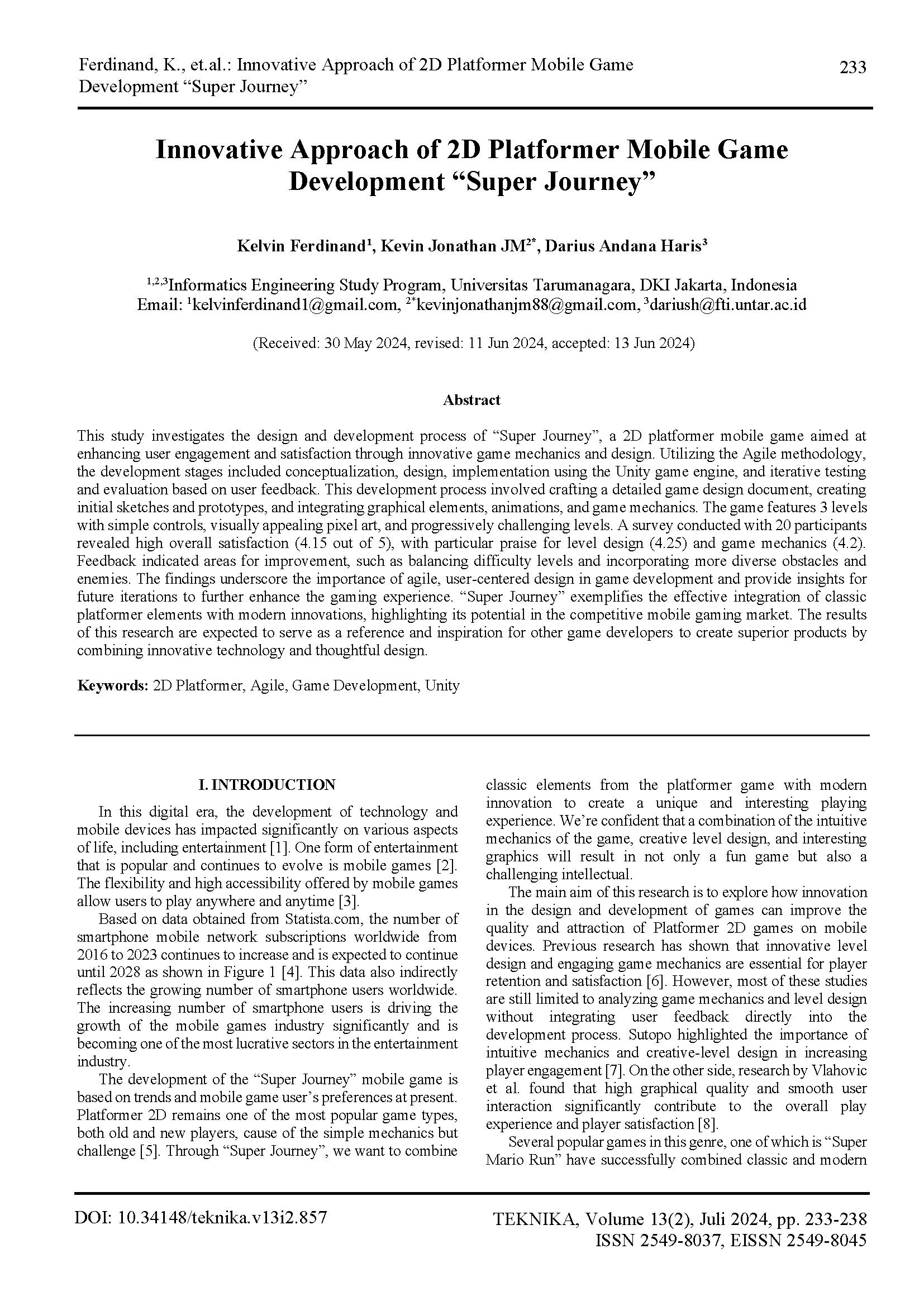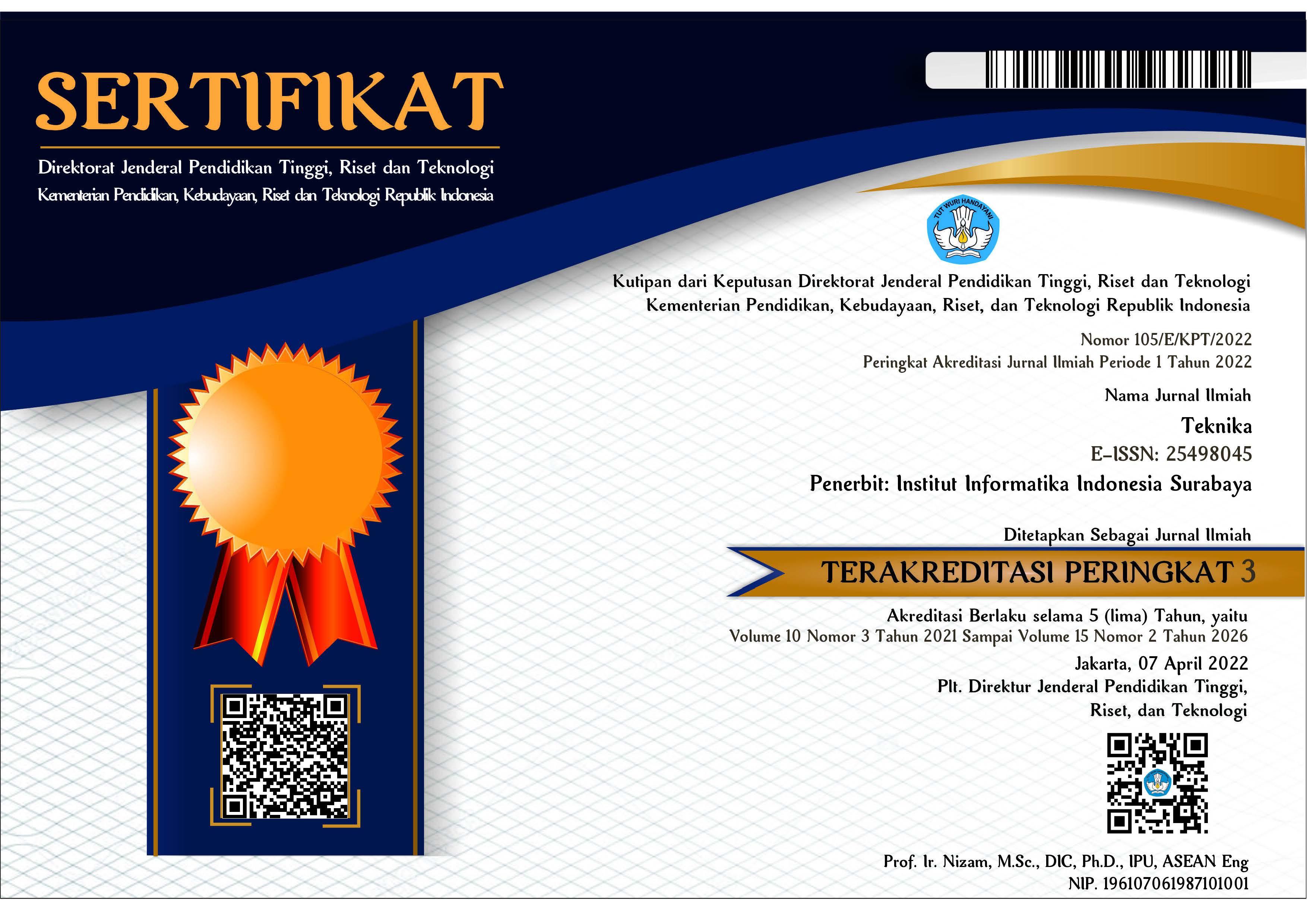Innovative Approach of 2D Platformer Mobile Game Development “Super Journey”
DOI:
https://doi.org/10.34148/teknika.v13i2.857Keywords:
2D Platformer, Agile, Game Development, UnityAbstract
This study investigates the design and development process of “Super Journey”, a 2D platformer mobile game aimed at enhancing user engagement and satisfaction through innovative game mechanics and design. Utilizing the Agile methodology, the development stages included conceptualization, design, implementation using the Unity game engine, and iterative testing and evaluation based on user feedback. This development process involved crafting a detailed game design document, creating initial sketches and prototypes, and integrating graphical elements, animations, and game mechanics. The game features 3 levels with simple controls, visually appealing pixel art, and progressively challenging levels. A survey conducted with 20 participants revealed high overall satisfaction (4.15 out of 5), with particular praise for level design (4.25) and game mechanics (4.2). Feedback indicated areas for improvement, such as balancing difficulty levels and incorporating more diverse obstacles and enemies. The findings underscore the importance of agile, user-centered design in game development and provide insights for future iterations to further enhance the gaming experience. “Super Journey” exemplifies the effective integration of classic platformer elements with modern innovations, highlighting its potential in the competitive mobile gaming market. The results of this research are expected to serve as a reference and inspiration for other game developers to create superior products by combining innovative technology and thoughtful design.
Downloads
References
A. M. A. Saputra, L. P. I. Kharisma, A. A. Rizal, M. I. Burhan, and N. W. Purnawati, Teknologi Informasi: Peranan TI dalam berbagai bidang. PT. Sonpedia Publishing Indonesia, 2023.
T. A. Pratama and H. Nugroho, ‘Games, Speed Effect dan Dampaknya terhadap Manusia: Dromologi dalam Perkembangan Game Online Mobile MOBA (Multiplayer Online Battle Arena)’, Jurnal Kawistara, vol. 13, no. 3, pp. 402–419, 2023.
M. K. K. Awan, ‘Penerapan Teknologi Komputasi Awan Pada Bidang Permainan (Game)’.
Statista, ‘Smartphone mobile network subscriptions worldwide 2016-2028’, 2024. [Online]. Available: https://www.statista.com/statistics/330695/number-of-smartphone-users-worldwide/. [Accessed: 24-May-2024].
Y. Prasetyawan, ‘Penciptaan Game" Nira: Tiga Kunci" dengan Teknik Pixel Art Digital 2D’, Institut Seni Indonesia Yogyakarta, 2021.
L. Zhang, Z. Shao, J. Benitez, and R. Zhang, ‘How to improve user engagement and retention in mobile payment: A gamification affordance perspective’, Decision Support Systems, vol. 168, p. 113941, 2023.
A. H. Sutopo, Pengembangan Educational Game. Topazart, 2020.
S. Vlahovic, M. Suznjevic, and L. Skorin-Kapov, ‘A survey of challenges and methods for Quality of Experience assessment of interactive VR applications’, Journal on Multimodal User Interfaces, vol. 16, no. 3, pp. 257–291, 2022.
R. W. P. Pamungkas, S. Kom, M. Kom, B. S. Zebua, and A. N. Azizah, ‘Peran Strategis Scrum Master Pada Pengembangan Perangkat Lunak di Sebuah Industri’, JTT (Jurnal Teknologi Terapan), vol. 9, no. 2, pp. 128–139, 2023.
M. Prabowo, Metodologi Pengembangan Sistem Informasi. LP2M Press IAIN Salatiga, 2020.
L. Magdalena, Scrum Agile: Optimalisasi Kualitas Produk Manajemen. PT. Sonpedia Publishing Indonesia, 2023.
S. B. Atim, ‘Permodelan Sistem Informasi Penjualan Barang Berbasis Website Menggunakan Metode Agile’, Journal of Artificial Intelligence and Technology Information, vol. 2, no. 1, pp. 14–25, 2024.
Y. S. Martyastiadi, ‘Estetika Interaksi dalam Gim Virtual Reality Borobudur’, Institut Seni Indonesia Yogyakarta, 2021.
B. Bagas Aulia Alfasyam, ‘Pengembangan Aplikasi Pengetahuan Bahasa Pemograman Dasar dan Lanjut Berbasis Android Menggunakan Metode Game Development Life Cycle’, Universitas Malikussaleh, 2023.
J. M. Manik, E. M. A. Jonemaru, and T. Afirianto, ‘Pengembangan Gim Edukasi Konsep Algoritma pada Mata Pelajaran Informatika Sekolah Menengah Pertama menggunakan Mechanics Dynamics Aesthetics (MDA) Framework’, Jurnal Pengembangan Teknologi Informasi dan Ilmu Komputer, vol. 7, no. 8, pp. 3595–3604, 2023.
M. Khaufillah, H. M. Az-Zahra, and B. T. Hanggara, ‘Perancangan Pengalaman Pengguna Sistem Pembelajaran Etika Komunikasi Mahasiswa Universitas Brawijaya Dengan Konsep Gamifikasi Menggunakan Pendekatan Player Centered Design’, Jurnal Pengembangan Teknologi Informasi dan Ilmu Komputer, vol. 3, no. 10, pp. 10008–10017, 2019.
B. Nicoll, B. Keogh, B. Nicoll, and B. Keogh, The Unity Game Engine and The Circuits of Cultural Software. Springer, 2019.
D. Santicho and C. K. Dewa, ‘Pengembangan Sistem Pengelolaan Rapat Menggunakan Django Framework Pada Prosa Meemo’, AUTOMATA, vol. 4, no. 1, 2023.
M. Mozgovoy and E. Pyshkin, ‘Unity application testing automation with appium and image recognition’, in Tools and Methods of Program Analysis: 4th International Conference, TMPA 2017, Moscow, Russia, March 3-4, 2017, Revised Selected Papers 4, 2018, pp. 139–150.
R. Y. Ariyana, E. Susanti, M. R. Ath-Thaariq, and R. Apriadi, ‘Penerapan Metode Game Devlopment Life Cycle (GDLC) pada Pengembangan Game Motif Batik Khas Yogyakarta’, INSOLOGI: Jurnal Sains dan Teknologi, vol. 1, no. 6, pp. 796–807, 2022.
M. A. P. Sujaya, I. G. M. Darmawiguna, and M. W. A. Kesiman, ‘Pengembangan Game RPG 2D Legenda Desa Trunyan’, INSERT: Information System and Emerging Technology Journal, vol. 2, no. 2, pp. 84–98, 2021.























